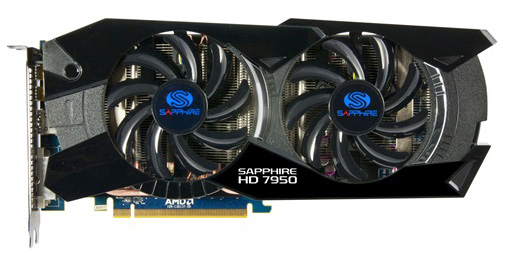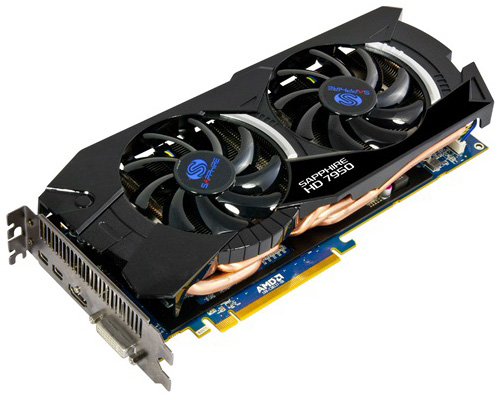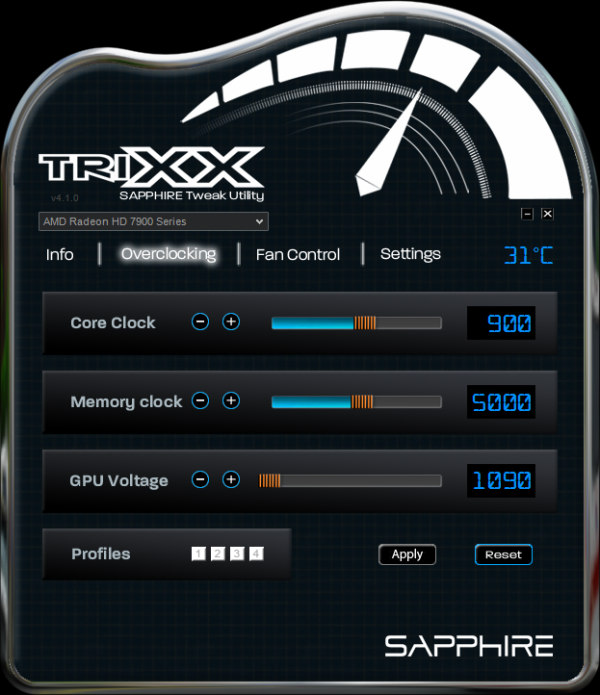AMD Radeon HD 7950 Review Feat. Sapphire & XFX: Sewing Up The High-End Market
by Ryan Smith on January 31, 2012 9:02 AM ESTMeet the Sapphire HD 7950 Overclock Edition
Since our reference 7950s are built on the 7970 PCB and cooler, we’re going to jump right into our vendor cards starting with the Sapphire HD 7950 Overclock Edition.
As with all of the 7950 cards launching today, Sapphire’s HD 7950 Overclock Edition uses the AMD 7950 PCB. This is a slightly shorter PCB measuring 10.25” long, saving .25” over the 7970 PCB by eliminating a few components that the lower board power of the 7950 makes unnecessary. The PCB is otherwise very similar to the 7970 PCB, utilizing 12 GDDR5 memory chips organized around the Tahiti GPU, while at the top you’ll find the 2 CrossFire connectors, a pair of 6pin PCIe power sockets, and the BIOS selection switch. The latter will be of particular interest to unlockers, as the switch should make it possible to safely attempt to unlock the 7950 into a 7970.

Moving on, as this is a semi-custom card the real differentiation is in the factory overclock and the cooler. On the performance side of things Sapphire will be shipping the 7950 Overclock Edition at 900MHz core and 5GHz memory, representing a 100MHz (12.5%) core overclock and no change on the memory clock.
Meanwhile for the cooler Sapphire is using what they’re calling the Dual-X cooler. The Dual-X is yet another double-wide dual-fan open air cooler, with 2 fans providing copious airflow over an aluminum heatsink running virtually the entire length of the card. Sapphire’s fan cutouts are just a bit bigger than most other dual-fan coolers and placed a bit higher, and as a result the Dual-X cooler is a bit taller than the PCB by about 15mm at its highest point. Meanwhile the cooler is also a fair bit longer than the PCB, putting the total card length at 11”.
Moving below the fans and the heatsink we’ll find the heatpipe assembly, which is responsible for carrying heat from the GPU to the heatsink. The Dual-X uses 5 copper heatpipes of varying radius that run from one end of the heatsink to the other. The 5 heatpipes converge at the base of the assembly, where a copper baseplate provides contact with the GPU. Meanwhile cooling for the VRM MOSFETs and RAM is provided by a black aluminum plate, which is placed over those components with heat transfer provided by the use of thermal pads. There is no connection between the plate and the heatsink, so the only heat dissipation from the plate is provided by whatever airflow from the fans reaches the plate.

At the front of the card we’ll find the display ports, which as this is an AMD PCB the card utilizes the standard AMD 7000 series port configuration of 1 DL-DVI port, 1 HDMI port, and 2 mini-DisplayPorts. Filling out the second slot is the grating for ventilation, though even with the ventilation slot the usual precautions for an open-air cooler apply: you’ll need a case with enough airflow to handle the roughly 200W of heat the card is capable of dumping inside of your case.
Rounding out the package is the usual collection of dongles and materials. Sapphire includes 2 molex-to-6pin PCIe adaptors, an HDMI to DVI dongle, a miniDP to DisplayPort dongle, a DVI to VGA dongle, and a 1.8m HDMI cable. Along with the dongles Sapphire packs a quick start guide and a driver installation CD.
The only thing you won’t find packed in the box is TriXX, Sapphire’s in-house overclocking utility. TriXX has been around since the 6900 series, but as this is the first high-end Sapphire card we’ve reviewed since it was released, this is the first time we’ve had it available for a review.
Fundamentally TriXX is a fairly well designed, albeit barebones overclocking utility. Along with an info readout similar to GPU-Z, TriXX provides overclocking and fan control support for Sapphire’s cards, including support for custom fan profiles and more importantly voltage control. With TriXX it’s possible to overvolt most of Sapphire’s performance and high-end cards, and as Sapphire uses AMD reference PCBs it also works with any other cards using AMD’s PCBs.
Beyond these features there’s little more to TriXX. It’s not an all-encompassing video card utility like MSI’s Afterburner, which means it comes up short if you need more functionality but it's exactly what you need if you just want to overclock. To that end it’s a clear step up compared to most other manufacturer’s poorly designed utilities, and from a design perspective its only real sin is the hard to read blue-on-black text. Otherwise it’s a competent overclocking utility that does exactly what it’s supposed to and provides voltage control for those who need it.
Finally, Sapphire will be selling the 7950 OE for $479, $30 over the baseline 7950 MSRP. Meanwhile the warranty on their card is their standard 2 year warranty.















259 Comments
View All Comments
Galidou - Tuesday, January 31, 2012 - link
Well then everything you said is nothing new, and is quite useless, that's what I meant. What's the point mentioning that it always has been like that and say it like if it's totally shocking like if it's new.''In other words, if you wanted this level of performance, you could've gotten it a year ago with the GTX 580 for almost the same price....over a year ago....
And that's why AMD's pricing of these parts fails.''
Than marketting the way is done nowadays is a big FAIL but everyone knows it, ALWAYS has been like that... Car manufacturer makes new cars every year and sometimes it's worse than last year's, and higher priced....
Ever heard of programmed obsolescence??
chizow - Tuesday, January 31, 2012 - link
But this ISN'T how it usually goes, its unprecedented which is why many observers are pointing out the inconsistency. Look at history and even your own examples to show how this is out of the norm.I will leave you with one final question and you try to answer it with a straight face.
If Nvidia launched their new "next-gen" architecture on a new process node like 15nm in 12-13 months and it was only 15-25% faster than the 7970 but cost 10% more, would you be happy with it and consider it some great victory???
I don't know, I mean every way you possibly look at this, it just isn't right.
xeridea - Tuesday, January 31, 2012 - link
I would poo my pants because Nvidia actually did a process shrink ahead of schedule. BY THE WAY 14nm is 2 shrinks from now, and will be about 5 years down the road.Following your conversation, you clearly don't know the reason behind pricing scheme. There is 0 competition with the 7900 series right now, and it is still better price/performace at its high price. Price will go down in time, but cards are always more expensive on release.... welcome to the real world.
You could get the 580 last year for $50 more than the 7950, while using 30-80W more power (idle-game), running 10-25C hotter under load, making more noise, and slightly less performance (even with fairly new drivers for 7950).
chizow - Tuesday, January 31, 2012 - link
Uh, no I understand perfectly why they're pricing it this way.They're trying to make money and capitalize on the brief period of time they can actually charge a premium for holding the performance crown.
But that's not going to stop keen observers like myself for calling them on it, especially when they're pricing last-gen performance at next-gen prices. They might swindle a few of their unwitting fans this time around but this will only hurt them in the long run. And by long, I mean as soon as Kepler launches.
mdlam - Tuesday, January 31, 2012 - link
Too bad your "keen" observations prevented you from noticing that Nvidia is also pricing their 14 month old technology at premium prices? Wait maybe it is because you are a Nvidia fanboy! I won't ever get swindled by AMD, I will only be swindled by Nvidia, says the retard.SlyNine - Tuesday, January 31, 2012 - link
Then go back and look at other launches. Get the facts and stop using Adhominem attacks and showing your ignorance.chizow - Tuesday, January 31, 2012 - link
No, Nvidia priced their last-gen performance based on last-gen premiums, you would expect the next-gen to shift these parts to obsolescence but obviously AMD doesn't feel their users possess the acumen to understand this paradigm.As for retards being swindled by Nvidia, lmao, the difference is, they would've been reveling in their ignorant bliss with this level of performance, 14 months ago. For the same price.
Its truly amazing though, because you're falling into the exact trap AMD expects you to fall for with the pricing of this card. Honestly how can anyone defend the price and performance metric of this card 14 months later?
mdlam - Tuesday, January 31, 2012 - link
AMD doesn't give a shit whether you fall for anything, neither does Nvidia. If enough people buy their cards at X price to support their billion dollar companies, then the price stays. If not, the price goes down. If more people than not refuse to buy the product, then price goes....up.... Whether its this metric or that metric or not fair or super clever AMD trap its all bullshit people make up who hold little educational knowledge in economics or business.mdlam - Tuesday, January 31, 2012 - link
People like you btw.chizow - Wednesday, February 1, 2012 - link
Sounds like someone missed their nap.AMD should care actually, because the only people who would even entertain buying one of these cards are their biggest fans, the ones who are going to feel the burn the worst when the floor drops on the pricing of these products.
Again, there is precedent for this, AMD did it to Nvidia in 2008 and Nvidia was cutting rebate checks. Do you think AMD is willing to do the same?